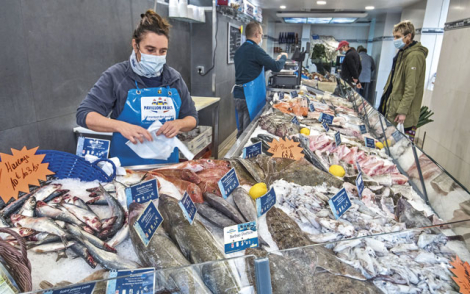Following the example of what is happening in butchers’shops, where matured meat has developed in recent years, fish wholesalers are upgrading their range of wild fish on offer particularly with Bass and Seabream. In the wake of restaurants offering carpaccio, tartare or ceviche, consumer awareness of the appearance of fish flesh is increasing. And with it, expectations in terms of texture and colour. "Regarding appearance, slaughtering using the ikejime method shows exceptional results" comments Kevin Hamelin, fish sales manager at the Rennes wholesaler Ame-Haslé.
High-end restaurant owners are very fond of this method, which means "killing the animal alive" when it comes out of the water rather than letting it die asphyxiated. In addition to its organoleptic advantages, it increases the preservation period of fish and permits maturation for up to three weeks. On average, ikejime fish, which are increasingly present at fish auctions in Finistère, are 20% more expensive.
Another trend in independent quality catering is the growing preference for organically farmed products instead of wild fish on the part of great chefs. "There is a growing awareness of the risks linked to the presence of pollutants in the sea," argues Mathias Ismaïl, R & O CEO. The company, which makes 52% of its turnover from restaurants, is the leading company in the distribution of organic seafood products and these ranges already make up 5% of its annual sales. In Greece, in the Gulf of Corinth, R & O manages a vertically-integrated organic production commercialised with the OSO brand, including hatching and on-growing. Last year, 500 tons were produced in this sector, half of which is divided between Bass and Seabream. By 2020, a production between 550 and 600 tons is anticipated. The main market for this production is bistro-style gastronomy and its customers, who are "aware of environmental issues", according to Mathias Ismaïl. "The products are often used in recipes inspired by Japan or Peru: raw or cooked in sauces, often with lemon juice. ”
Restaurants have expectations concerning the size of products and they need them to be easy to use. On the one hand, chefs are asking for rather large pieces which they will cut themselves. On the other hand, managers in brasseries or in institutional catering - for their management meals- , want products which are above all easy to use and to integrate into their menu. "They want ready-to-snack products which require as little work as possible," says Kevin Hamelin of Ame-Haslé.
Bertrand GOBIN
Translation : Catherine ROUSSEY
To see more : BASS SEABREAM : ENTERING A NEW ERA

